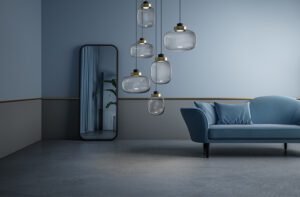A Virtual Reality Where Architecture is the Name of the Game
July 21, 2018
SPONSORED CONTENT
Text by Debra Judge Silber
You can’t walk into a house that hasn’t been built. That’s a fact. But in today’s reality—today’s virtual reality, that is—you can have an experience that’s pretty darn close.
In recent years, virtual reality—a computer-generated simulation that places users in an interactive, three-dimensional environment—has been used in medicine, manufacturing, education, and other fields. The technology is also opening new doors in residential design and construction. With virtual reality, architects can invite their clients to walk through rooms while plans are still on the drawing board. Designers can bring visitors into a kitchen, then swap out a countertop for a new look. Developers can invite prospective buyers to tour a model home without leaving their office. And builders can head off change orders by placing their clients in that bath remodel before a single tile is disturbed.
The most recent developments in virtual reality, including new plug-and-play software designed to work with existing BIM programs such as Sketchup and Revit, promise to make stepping into this virtual world as easy as donning an HMD (Head Mounted Display, for the uninitiated). That said, professionals who want to employ virtual reality for more than gimmicks should consider some guidance.
The truth is that virtual experience technology is advancing at a furious pace, and creating a seamless virtual experience requires knowledge of that technology and skill in applying it. It also often demands more robust computing power than is found on the desktops at most architectural or construction firms.
What’s more, successfully using virtual reality to design homes requires sensitivity to the built environment that’s lacking in the game-centric firms at the forefront of this technology, says Paul Saraiva, founder of Sensuus, an emerging Boston-based consultancy.
With a degree in architecture from Wentworth Institute of Technology and more than 10 years of experience in high-end residential design and construction, Saraiva is well acquainted with the challenges architects face in communicating what’s on their blueprints to their clients. But it was while working with an advertising company in the wake of the recession that he realized how virtual experiences could meet those challenges.
After a wildly successful campaign that used virtual reality technology to market Marvin’s Integrity windows, Saraiva decided to test the technology on a house he was designing. The project had stalled when the clients couldn’t decide on a two-story open foyer in their new home. So Saraiva imported his architectural drawings into a virtual reality platform, optimized them for the new technology, and called the client. “He walked in, put on the headset and before he knew it he was standing in the foyer,” Saraiva said. The initial reaction was immediate: “He was blown away,” said Saraiva, but more important—within seconds of entering his virtual foyer—the client made the decision he and his wife had been agonizing over. “He was finally able to understand what the space felt like, with true size and scale. And we were still in the design process. Nothing had been built,” Saraiva said. “That night, I came home and told my wife, ‘This could be something super beneficial for the industry.’ ”
A year later he launched Sensuus. The name combines the Latin words sensuro, meaning to feel or perceive, and locus, meaning space. The emphasis, he explains, is architectural visualization—not virtual reality. “We didn’t want to be a tech company that happens to do this for architecture,” he explained. Rather than present the technology as a gimmick, Saraiva emphasizes its role in the design process. “We want to help people understand what a space feels like. We view virtual reality as the best way to do that.”
Sensuus uses technologies that include Unreal Engine, a platform developed by gamers that creates the illusion of moving through an environment. It offers the sensation of moving from room to room, even as the user remains within a 12-by-12-foot space. It is a far more immersive experience than that provided by mobile virtual reality, which enables a 360-degree view, but only from a fixed position. Also, key to the experience is the optimization that Sensuus performs on the files it translates from BIM to VR. Saraiva applies his architectural background to edit the visual file, adding light effects and material details that he knows matter to architects and their clients. Optimization skill alone is why many architectural firms outsource their simulated 3D environment projects, according to AEC Magazine. “This is one area where specialist virtual reality consultancies earn their keep with finely tuned processes for a task like simplifying geometry, adding lighting, fixing gaps in the model and culling objects that will not be visible in the scene,” notes one article.
For Saraiva, though, it all comes back to the client’s engagement with the process. “I have this story in my head,” he says, and he describes two colleagues—both having new homes built—meeting in their office one Monday morning. The first whips out a cell phone to show off the latest elevations of his new home. “That’s cool,” Saraiva imagines the other one saying before he shares the experience Sensuus might provide: “I was in my house on Saturday.”
Sensuus
198 Tremont St.
Suite 248
Boston, MA
617-906-6744
Sensuus.com
Share
![NEH-Logo_Black[1] NEH-Logo_Black[1]](https://b2915716.smushcdn.com/2915716/wp-content/uploads/2022/08/NEH-Logo_Black1-300x162.jpg?lossy=1&strip=1&webp=1)















You must be logged in to post a comment.